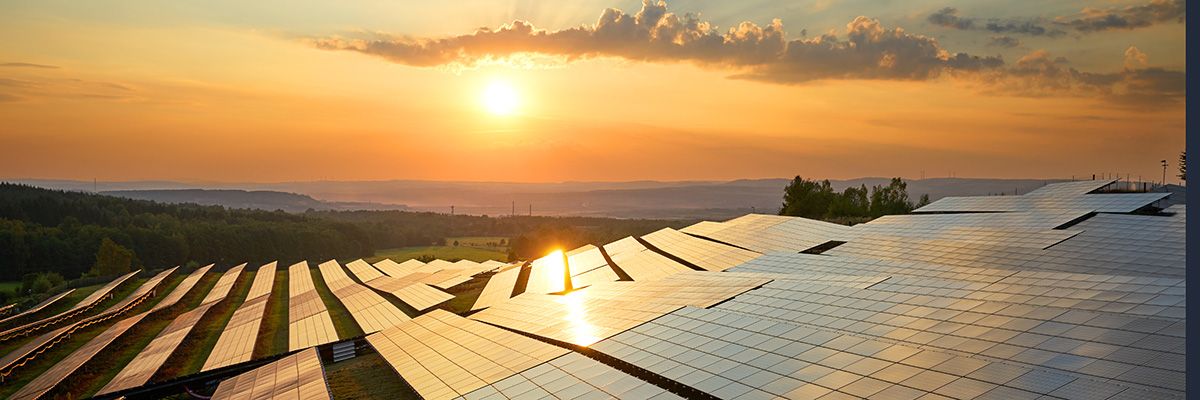
Solar solution evaluation and implementation
In this blog, we will investigate solar solutions for facilities, but before we get to that topic, let’s briefly familiarize ourselves with the subject of renewable energy, of which solar is one example.
You’re probably familiar with the term “renewable energy.” It has not been short of column inches in the mainstream, let alone trade, media. Renewable energy is simply energy that comes from natural (and renewable) sources, is generally clean, and has a low impact on the environment. Obvious examples of this are solar, wind, and water. Renewables can also be easily replenished (hence the name), so the supply is essentially limitless. Today, with facilities managers under pressure to find energy sources that are sustainable, reliable, and cost-effective it’s easy to see the appeal.
The benefits of renewables
It's also not hard to see the benefits, among them:
- Lower energy costs: After accounting for the initial investments, limitless supply translates to reduced costs for the facility in the long run.
- Lower environmental impact: characterized by reduced emissions.
- Improved energy security: renewable energy sources are independent of traditional energy sources, so they are more reliable.
Solar solutions are among many varieties of renewable energy, one of the most popular choices for facilities managers. We see primarily solar panels, often installed on the roof of a facility, to capture solar energy and convert it into electricity. Other common examples of renewable energy include wind energy, with turbines sometimes installed on-site at facilities to convert wind into electricity; hydropower, which performs the same conversion using flowing water as a source; and increasingly, biomass energy which creates power from organic materials that are burned to generate heat or electricity.
Evaluating solar energy-why?
Having understood something about renewables, the question of whether solar is worth pursuing comes next for the facilities manager. Given the provisions for alternative energy in the Inflation Reduction Act, the answer may be “yes.” Provisions to support alternative energy are various and include:
- Renewable Energy Production Tax Credit (PTC) - tax credit for renewable energy production
- Investment Tax Credit (ITC) – a tax credit for solar energy investments
- Energy-Efficient Commercial Building Deduction – deduction for energy-efficient upgrades to commercial buildings
Taking advantage of such incentives will enable facilities to improve efficiency, reduce energy costs, and increase sustainability.
There’s also the question of purchase power agreements (PPA). These are contracts between a solar developer and a commercial facility to purchase electricity generated by a solar system at a fixed rate per watt. PPAs mean no upfront costs, predictable energy charges, and reduced administrative requirements.
For the commercial facility, this PPA can be attractive. Instead of using capital to install on-site solar, they can access renewable energy without significant upfront investment and avoid the maintenance responsibilities of the solar system. PPA can also provide a long-term fixed price for electricity and can help avoid utility rate price hikes, which can, in turn, help with budgeting and planning.
The on-site question
So far, we’ve looked at options for solar energy from secondary sources. What about onsite solar? The central question is what sort of return on investment can be expected, and how can the facilities manager expect to benefit?
Several variables influence the ROI for on-site solar as a capital improvement, so it takes time to make a definitive, generalized statement. They include:
- Size of the solar system
- Type of inverter used
- Location (within the facility)
- Cost of electricity
- Cost of financing
Broadly (depending on the factors above), on-site break even can be expected after somewhere between 5 and 10 years. The chosen technology also plays a significant role in this determination, and in the subsequent CAPEX and OPEX returns of the system.
The bottom line is that on-site solar will deliver financial advantages though they won’t be realized immediately. It’ll also increase energy resilience, promote sustainability, reduce greenhouse gas emissions, and provide reputational benefits.
Implementation overview
If the choice is on-site solar, then the question of implementation arises. We’ve already seen that each solar project is different, but we can still identify some general steps that should be common to any installation project. These are:
- Compile a solar action plan – likely utilizing an expert solar consultant
- Evaluate, modify, approve, and adopt the plan – as required
- Address funding for the implementation
- Installation – Acquiring a solar service provider
- Identify and contract “external” service providers – for maintenance, operations, etc.
- Post-project review – again with an expert consultant, to identify any support needs
- Consider and execute pilot projects for additional implementations
The steps above seek to give only a general idea of the implementation process, but they include its key components. You’ll notice the importance of bringing in experience from outside the organization: if you’re not already familiar with the technology then consulting expertise is required.
The NexRev advantage
NexRev, we’ve been unlocking the power of facility and energy management data with over a million connected devices across North America. Our team of experts is focused on helping you deliver more with your budgets, infrastructure, and assets to create sustainable savings in operations and energy, reducing your risk and increasing operational confidence. Please email us at